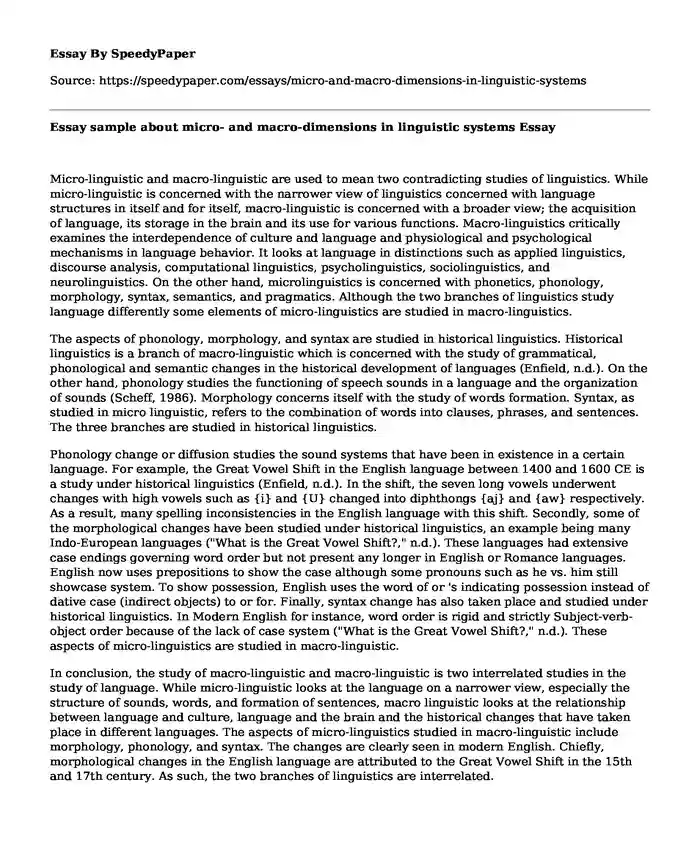
| Type of paper: | Essay |
| Categories: | Linguistics Languages |
| Pages: | 3 |
| Wordcount: | 584 words |
Micro-linguistic and macro-linguistic are used to mean two contradicting studies of linguistics. While micro-linguistic is concerned with the narrower view of linguistics concerned with language structures in itself and for itself, macro-linguistic is concerned with a broader view; the acquisition of language, its storage in the brain and its use for various functions. Macro-linguistics critically examines the interdependence of culture and language and physiological and psychological mechanisms in language behavior. It looks at language in distinctions such as applied linguistics, discourse analysis, computational linguistics, psycholinguistics, sociolinguistics, and neurolinguistics. On the other hand, microlinguistics is concerned with phonetics, phonology, morphology, syntax, semantics, and pragmatics. Although the two branches of linguistics study language differently some elements of micro-linguistics are studied in macro-linguistics.
The aspects of phonology, morphology, and syntax are studied in historical linguistics. Historical linguistics is a branch of macro-linguistic which is concerned with the study of grammatical, phonological and semantic changes in the historical development of languages (Enfield, n.d.). On the other hand, phonology studies the functioning of speech sounds in a language and the organization of sounds (Scheff, 1986). Morphology concerns itself with the study of words formation. Syntax, as studied in micro linguistic, refers to the combination of words into clauses, phrases, and sentences. The three branches are studied in historical linguistics.
Phonology change or diffusion studies the sound systems that have been in existence in a certain language. For example, the Great Vowel Shift in the English language between 1400 and 1600 CE is a study under historical linguistics (Enfield, n.d.). In the shift, the seven long vowels underwent changes with high vowels such as {i} and {U} changed into diphthongs {aj} and {aw} respectively. As a result, many spelling inconsistencies in the English language with this shift. Secondly, some of the morphological changes have been studied under historical linguistics, an example being many Indo-European languages ("What is the Great Vowel Shift?," n.d.). These languages had extensive case endings governing word order but not present any longer in English or Romance languages. English now uses prepositions to show the case although some pronouns such as he vs. him still showcase system. To show possession, English uses the word of or 's indicating possession instead of dative case (indirect objects) to or for. Finally, syntax change has also taken place and studied under historical linguistics. In Modern English for instance, word order is rigid and strictly Subject-verb-object order because of the lack of case system ("What is the Great Vowel Shift?," n.d.). These aspects of micro-linguistics are studied in macro-linguistic.
In conclusion, the study of macro-linguistic and macro-linguistic is two interrelated studies in the study of language. While micro-linguistic looks at the language on a narrower view, especially the structure of sounds, words, and formation of sentences, macro linguistic looks at the relationship between language and culture, language and the brain and the historical changes that have taken place in different languages. The aspects of micro-linguistics studied in macro-linguistic include morphology, phonology, and syntax. The changes are clearly seen in modern English. Chiefly, morphological changes in the English language are attributed to the Great Vowel Shift in the 15th and 17th century. As such, the two branches of linguistics are interrelated.
References
Enfield, N. J. (n.d.). Micro- and macro-dimensions in linguistic systems. Reviewing Linguistic Thought. doi:10.1515/9783110920826.313
Scheff, T. J. (1986). Micro-Linguistics and Social Structure: A Theory of Social Action. Sociological Theory, 4(1), 71. doi:10.2307/202106
What is the Great Vowel Shift? (n.d.). Retrieved from http://facweb.furman.edu/~mmenzer/gvs/what.htm
Cite this page
Essay sample about micro- and macro-dimensions in linguistic systems. (2022, Oct 28). Retrieved from https://speedypaper.com/essays/micro-and-macro-dimensions-in-linguistic-systems
Request Removal
If you are the original author of this essay and no longer wish to have it published on the SpeedyPaper website, please click below to request its removal:
- Essay Example: Why Do People Judge Others by Clothes
- Business Organizations
- Management Essay Sample: Foundations for Organization Structure
- Essay Sample: The Lack of Protection of the Victims of Domestic Violence under Asylum Law
- Analysis Essay Sample on 1984 by George Orwell
- Essay Sample on New Approach to Renewable Energy in Urban Areas
- Constructivism: Tailoring the Learning Experience for Human Potential - Paper Example
Popular categories




